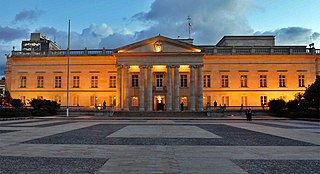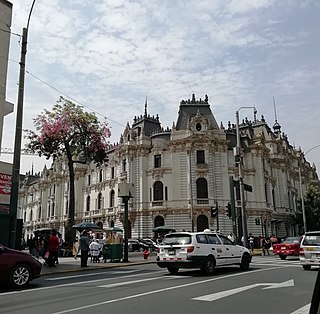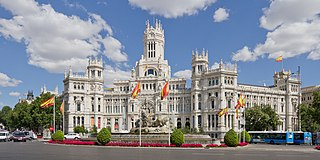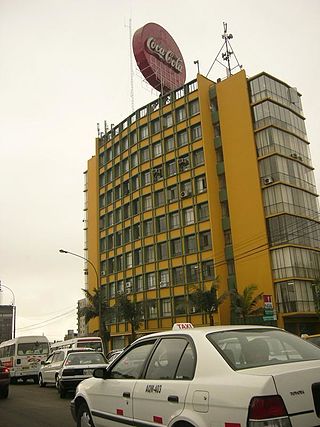
The Historic Centre of Lima is the historic city centre of the city of Lima, the capital of Peru. Located in the city's districts of Lima and Rímac, both in the Rímac Valley, it consists of two areas: the first is the Monumental Zone established by the Peruvian government in 1972, and the second one—contained within the first one—is the World Heritage Site established by UNESCO in 1988, whose buildings are marked with the organisation's black-and-white shield.

Carabayllo is one of the 43 districts of the province Lima in Peru. It is located in the Cono Norte area of the province and was created district by General José de San Martín in August 4, 1821 at which time it was the only district to occupy the area north of the Rímac River up to the province Canta.

The Casa de Nariño, literally the House of Nariño, is the official residence and principal workplace of the President of Colombia. It houses the main office of the executive branch and is located in the capital city of Bogotá, Colombia. It was dedicated in 1908 after being constructed on the site of the house where Antonio Nariño was born. The design was made by architects Gastón Lelarge, a French-born former pupil of Charles Garnier, and Julián Lombana.

The Jirón de la Unión, or Union Street, is a pedestrian street located in the Historic Centre of Lima, part of the capital of Peru. For many decades it was the most important boulevards of the city, often described as the most aristocratic, where many of the most affluent citizens of the city and most powerful men around the world would meet. Subsequently, with the deterioration of the center of Lima, the Jirón de la Unión lost its aristocratic character and became completely commercialized.

Barrios Altos is a Peruvian neighbourhood that forms the eastern part of Lima District, part of the historic centre of the city. It owes its name to the fact that, topographically, it is higher than the rest of the old part of the City, due to the elevation of the land that exists towards the Andes mountain range, which is evident in its streets to this day.

The Casa de los Azulejos or Palacio de los Condes del Valle de Orizaba is an 18th-century Baroque palace in Mexico City, built by the Count of the Valle de Orizaba family. The building is distinguished by its facade, which is covered on three sides by blue and white colonial Talavera tiles from Puebla state. The palace remained in private hands until near the end of the 19th century. It changed hands several times before being bought by the Sanborns brothers who expanded their soda fountain/drugstore business into one of the best-recognized restaurant chains in Mexico. The house today serves as their flagship restaurant.

The Palace of the Marquis del Apartado is a historic residence located in Mexico City, just to the northeast of the city's Zocalo in the Historic center of Mexico City.

Cibeles Palace, formally known as Palacio de Comunicaciones and Palacio de Telecomunicaciones until 2011, is a complex composed of two buildings with white facades and is located in one of the historical centres of Madrid, Spain. Formerly the city's main post office and telegraph and telephone headquarters, it is now occupied by City Council of Madrid, serving as the city hall, and the public cultural centre CentroCentro.

The Plaza de Armas is the main square of Santiago, the capital of Chile. Plaza de Armas metro station is located under the square. Surrounding the square are some historic buildings, including the Metropolitan Cathedral of Santiago, Central Post Office Building, Palacio de la Real Audiencia de Santiago, and the building that serves as the seat of local government for Santiago, which was formerly occupied by the Cabildo of the city before being remodeled. There are also other architecturally significant buildings that face the square, including the Capilla del Sagrario, the Palacio arzobispal, the Edificio Comercial Edwards, and the Portal Fernández Concha. The Casa Colorada, the Cuartel General del Cuerpo de Bomberos de Santiago and the Museo Chileno de Arte Precolombino are located a short walk from the square.
The Palacio del Marqués de Casa Riera was the name for two successive buildings located in the same place, in the Spanish city of Madrid, in the number 64 of the Calle de Alcalá, it was in the widest part of the street.

The Palacio del Marqués de Portugalete was a grand palace built in the 1860s, located at 56 Calle de Alcalá, on the corner of Calle Alfonso XI, in Madrid. Also known as the Palace of Bailén, it belonged to the family of Francisco Javier Castaños y Aragorri, a descendant of General Francisco Castaños, who was the victor at the Battle of Bailén. It was built by architect Adolfo Ombretch, who also built the nearby palace of Linares. For many years it was a venue for the wealthy elite to meet and discuss national politics. It was demolished after the Spanish Civil War, and in 1946, replaced by the National Institute of Forecast, now occupied by the National Institute of Health.

The Palacio del Marqués de Alcañices, also known as Palacio de Alcañices, was a building, now disappeared, which was located in the Calle de Alcalá of Madrid on the land that was other building that occupied Luis Méndez de Haro 6th Marquis del Carpio, a favorite of Philip IV. It belonged to the parish of San Sebastián, and occupied the number 74 of the modern numbering of the street; its other façade bordering the Paseo del Prado. Was named after its owners, the last one José Osorio y Silva, mentor of Alfonso XIII, known as Pepe Osorio and the Grand Duke of Sesto, who also held the title of Marquess of Alcañices, among others.

Old Town of Cáceres is a historic walled city in Cáceres, Spain.

The Palace of the Counts of Maceda, or Casa del Barón in Pontevedra, Spain, is an original Renaissance pazo dating from the 16th century. It is currently a four-star hotel belonging to the Paradores network.

The Casa Marsano, also known as the Marsano Palace, was a palace in Miraflores District, Lima.

The Limatambo Building, also known as the Seoane Building, was a building in Lince District, Lima. The building was known for its billboards, most of which promoted the Coca-Cola Company.

The Casa Suárez is a house located in the city of Lima, Peru. It was declared Cultural heritage of the Nation in May 2007.

Chabuca Granda Promenade is a large promenade of the city of Lima adjacent to the Government Palace and on the banks of the Rímac River. It has three amphitheatres and stages for varieties and Música criolla.

Tacna Avenue, formerly Jirón Tacna, is one of the main avenues that surround the Damero de Pizarro in the historic centre of Lima, Peru. It starts at the Puente Santa Rosa, and continues until it reaches Wilson and La Colmena avenues. It is prolonged to the south for two blocks and to the north until it reaches Rímac Avenue in San Juan de Lurigancho.

Polvos Azules is a shopping centre located in La Victoria District, Lima, Peru. Originally located behind Government Palace, it has since moved to its current location next to the Paseo de la República expressway, keeping the name it inherited from its original location, today the Alameda Chabuca Granda.




















